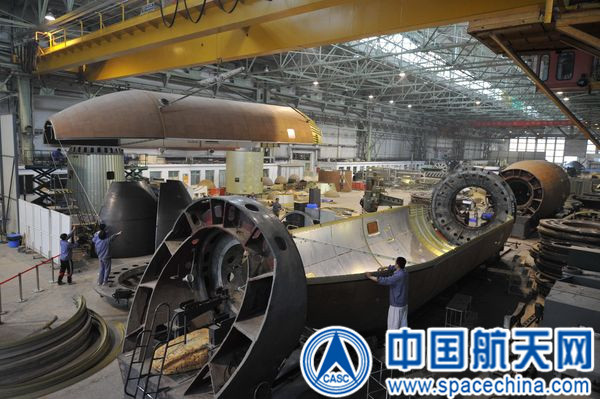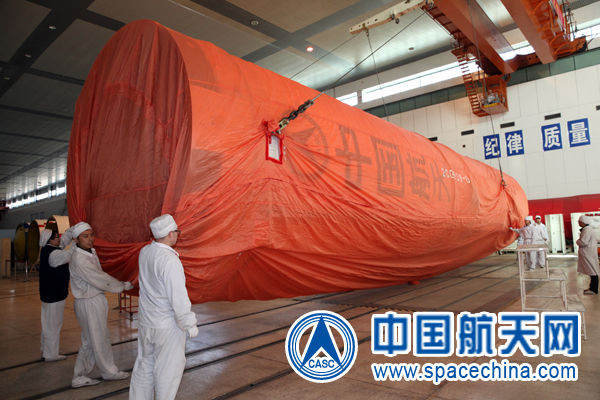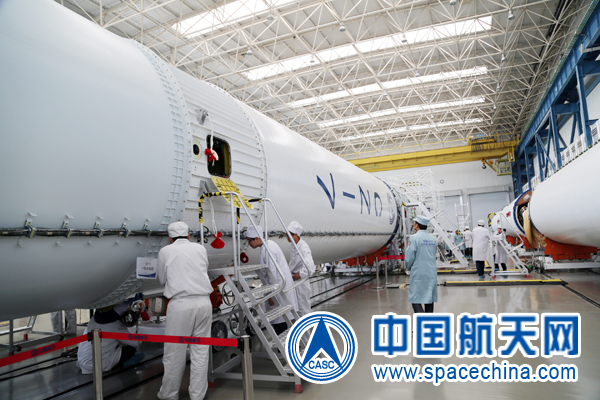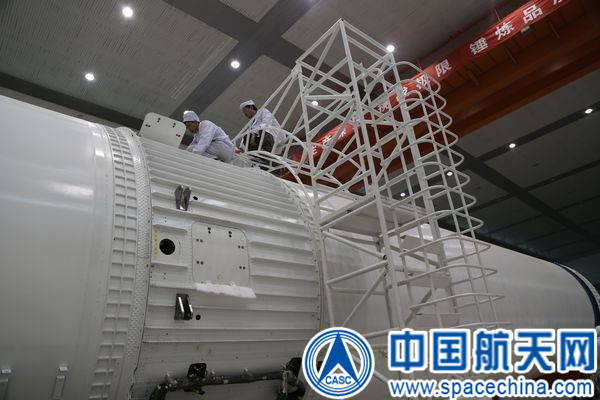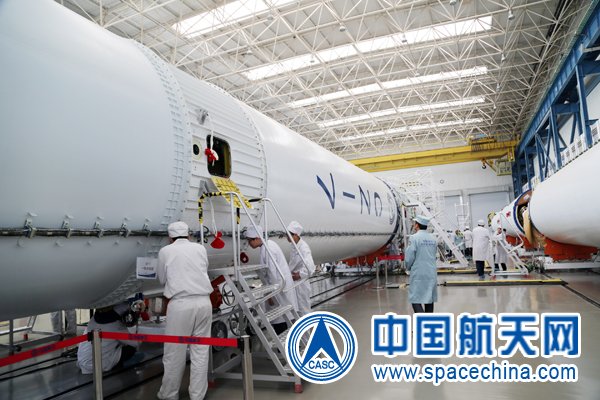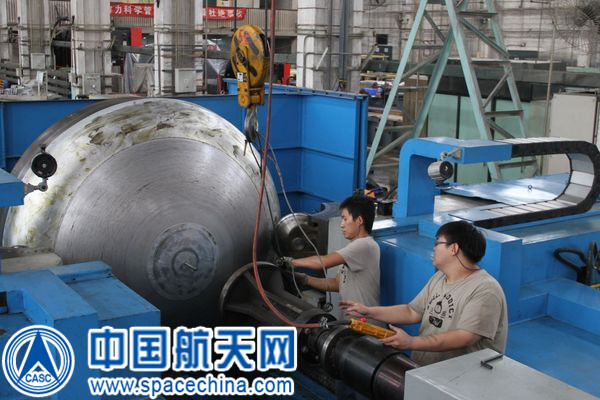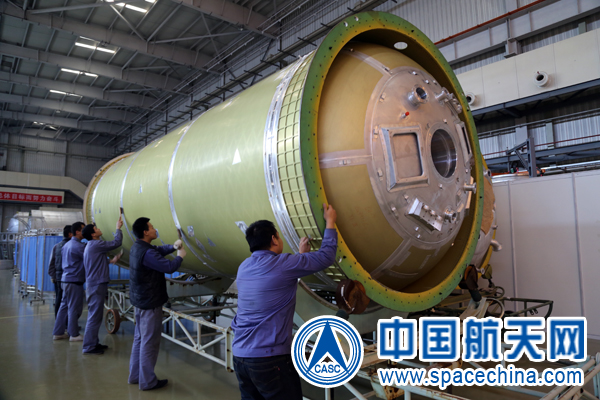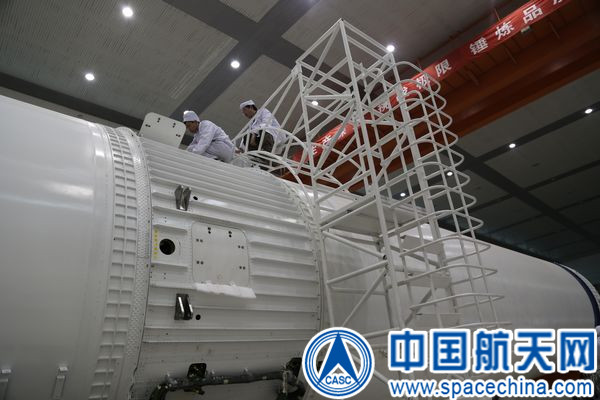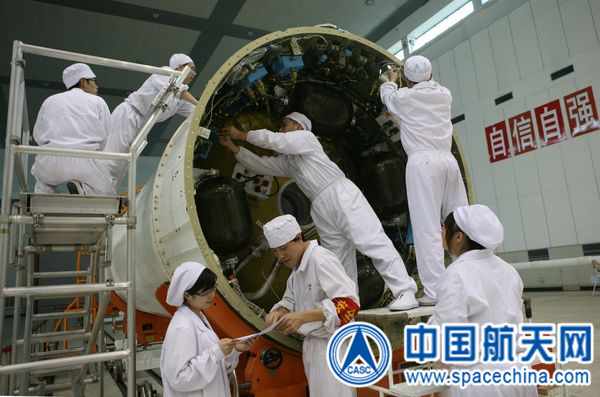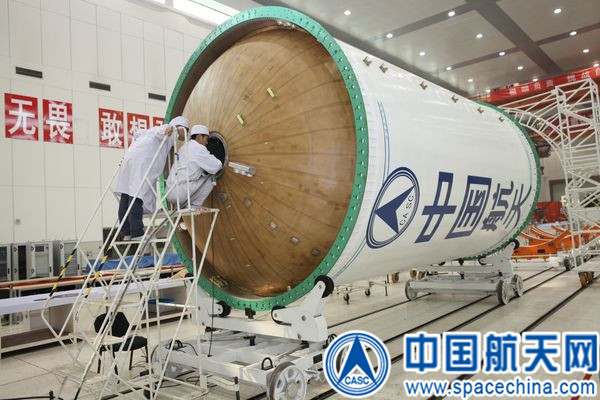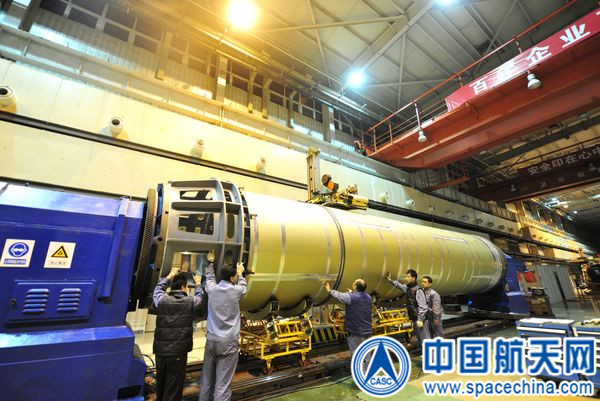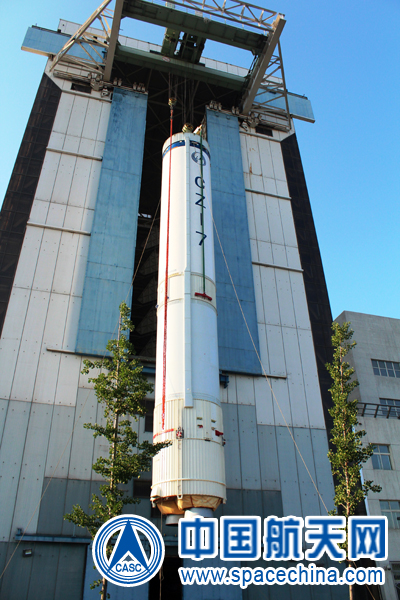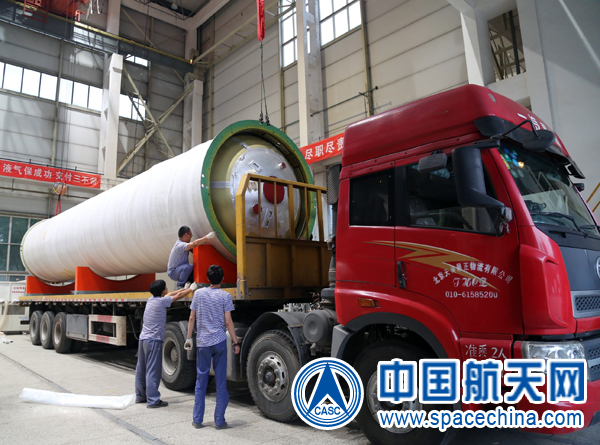Long March 7 Launch Vehicle
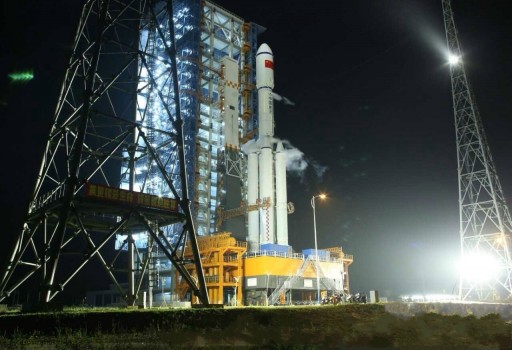
Long March 7, also known as Chang Zheng 7 (CZ-7), is a Chinese Space Launch Vehicle that builds the medium-lift component in China’s next generation of orbital launch systems, operated alongside the Long March 5 and 6 as well as the existing CZ-2/3/4 rockets. The new line of CZ-5/6/7 rockets facilitates a major shift in launch vehicle technology, switching from mostly hypergolic- or solid-fueled launchers to more environmentally friendly Kerosene/LOX propellants.
Taking the medium-lift spot in the new generation of launchers, Long March 7 is joined by the light-lift Long March 6 and the heavy-lift Long March 5. The new launchers use modular systems and common components across the different rockets as a cost-saving and simplification measure, allowing a quick build-up of heritage and permitting a streamlined production of launch vehicles to support an ever growing number of missions.
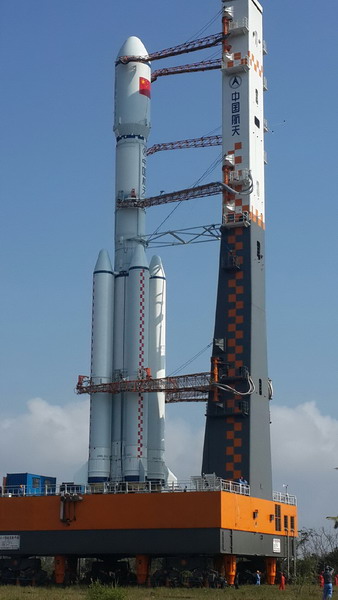
The need for the development of new rockets arose due to a shift in launch requirements to medium- and heavy-weight payloads such as regular flights of crew and cargo vehicles to China’s upcoming space station. The existing launchers were on the lower end of the required lift-class and employed highly toxic propellant combinations, not ideal for regular crew missions. The goal of the new line of rockets is to establish a safe, reliable, flexible and economical space launch architecture.
The Long March 7 rocket started out under the name Long March 2F/H as a modernized version of the CZ-2F used in China’s Crewed Space Program. Later the project evolved into a new medium-lift launcher to employ the technologies developed for the new-generation of rockets and enable CZ-7 to fill the performance gap between the small CZ-6 and the heavy-lift Long March 5.
Development work for the Long March 7 was completed by the China Academy of Launch Vehicle Technology (CALT), starting in 2010. The maiden flight of the CZ-7 rocket was repeatedly delayed and is currently expected in mid-2016.
Initially, Long March 7 will be operated from the Wenchang Satellite Launch Center on Hainan Island, though it is expected that the inland launch centers will be adapted for use by the CZ-7 in the future. Over a period of years, the CZ-5/6/7 rockets will demonstrate their capabilities and reliability before they will become China’s primary space launch vehicles when the CZ-3/4 series retire in the first half of the 2020s. Crewed launches are expected to continue using the Long March 2F until the late 2020s before shifting to a successor vehicle, likely Long March 7.
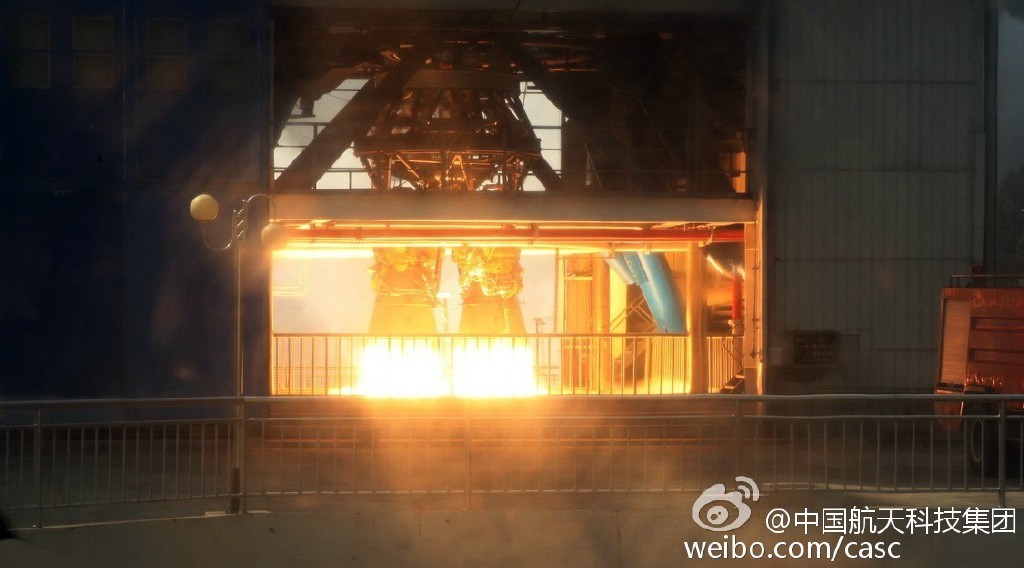
Long March 7 Specifications
| Type | Long March 7 (CZ-7) |
| Height | 53.1 m |
| Diameter | 3.35 m |
| Dry Mass | ~44,000 kg |
| Launch Mass | 594,000 kg |
| Stages | 2 |
| Boosters | 4 |
| Mass to LEO | 13,500 kg |
| Mass to GTO | 7,000 kg |
| Mass to SSO | 5,500 kg |
The Long March 7 launch vehicle is a two-stage rocket with four liquid-fueled boosters clustered around the first stage. Structurally, the vehicle employs a design similar to the Long March 2F rocket currently used in China’s manned space program – CZ-7 inherits the overall dimensions of the Long March 2F with respect to core and booster diameter. The two stages as well as the boosters consume Kerosene fuel and Liquid Oxygen as oxidizer.
Long March 7 stands 56.1 meters tall, has a core diameter of 3.35m, creating a span of over eight meters from booster side fin to booster side fin. The vehicle has a launch mass of 595 metric tons and is capable of delivering payloads of up to 13,500 Kilograms to Low Earth Orbit – making it suitable for the launch of crew and cargo craft to China’s future space station. The vehicle can deliver satellites up to 5,500 Kilograms to a 700-Kilometer Sun-Synchronous Orbit, expanding performance to this particular orbit when compared to the CZ-2 and 4 vehicles currently employed for SSO missions.
The Long March 7 uses YF-100 engines on its boosters and core stage and the YF-115 is employed on the second stage. These engines were developed for use across the CZ-5/6/7 series to increase commonality and streamline production.
First Stage
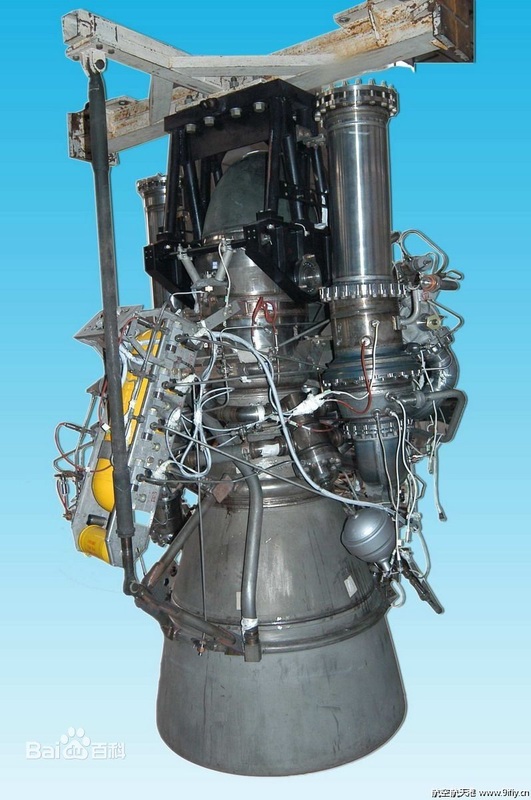
| Type | K3-1 |
| Length | 26m |
| Diameter | 3.35m |
| Inert Mass | ~12,000kg |
| Propellant Mass | ~174,000kg |
| Fuel | Kerosene |
| Oxidizer | Liquid Oxygen |
| Tank Material | Aluminum Alloy |
| Tank Construction | Separate Bulkheads |
| Tank Pressurization | Engine Bleed, Helium |
| Propulsion | 2 x YF-100 |
| Engine Type | Staged Combustion |
| Propellant Feed | Turbopump |
| YF-100 Thrust (SL) | 1,180kN |
| YF-100 Thrust (Vac) | 1,340kN |
| Impulse (SL) | 300s |
| Impulse (Vac) | 335s |
| Ox. To Fuel Ratio | 2.6 |
| YF-100 Flowrate | ~410kg/s |
| Engine Length | 2.99m |
| Engine Diameter | 1.35m |
| Chamber Pressure | 180bar |
| Throttle Range | 65-100% |
| Burn Time | ~190 sec |
| Attitude Control | Two-Axis Engine Gimbaling |
The first stage of the CZ-7 launch vehicle is a K3-1 rocket module that shares commonality with the first stage of the Long March 2F in that it retains the 3.35-meter diameter.
However, changes to the 2F version are stretched tanks, a different propellant combination and different propulsion system. K3-1 stands approximately 26 meters tall and has an inert mass on the order of 12.5 metric tons. At liftoff, it holds around 174 metric tons of Liquid Oxygen and Kerosene propellants.
The K3-1 rocket module contains the Kerosene fuel tank located below the Liquid Oxygen Tank. The LOX feedline is routed through a tunnel in the fuel tank which increases packing efficiency. Aluminum alloy is used for the propellant tanks with a wall thickness of 1.7 millimeters.
Tanks holding pressurant gas to keep the tanks at the proper pressure during flight are installed within the LOX tank for improved gas storage efficiency.
The CZ-7 first stage is powered by a pair of YF-100 engines which are individually gimbaled to provide three-axis control to the vehicle.
Development of the YF-100 engine started in the early 2000 under direction by the China National Space Administration.
It is based on the Russian RD-120 engine that was acquired by China in the 1990s and is still in use aboard the Zenit rocket’s second stage.
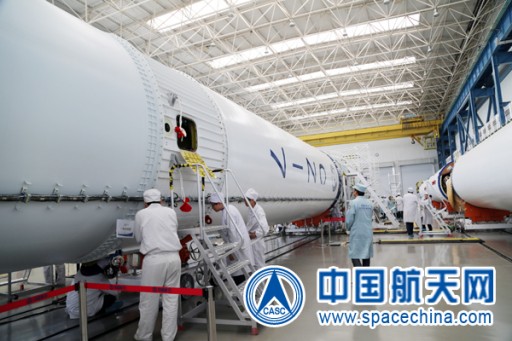
The YF-100 engine entered its testing program in 2005 which was completed by the end of 2007 with official acceptance testing complete by May 2012 – clearing the engine for use aboard China’s future launch vehicles. It is currently in use by the Long March 5, 6 and 7 vehicles.
YF-100 is a high-pressure staged combustion engine employing an oxygen-rich preburner that generates hot, high-pressure gas by burning a portion of the fuel inflow in an oxygen-rich environment to drive the turbine of the oxidizer and fuel turbopumps which use a single shaft and deliver the propellants to the combustion chamber of the engine.
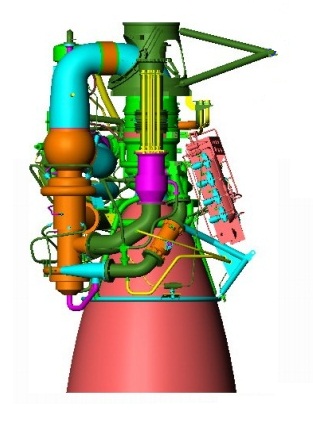
The YF-100 engine operates at a chamber pressure of 180 bar to generate a sea level thrust of 1,180 Kilonewtons (120,300 Kilogram force) that rises to 1,340kN in the rarefied upper atmosphere (136,650kgf) at corresponding specific impulses of 300 and 335 seconds.
YF-100 is 1.35 meters in diameter and measures 2.99 meters in length. The engine operates at a mixture ratio of 2.6 and can be throttled down to 65% of rated performance to allow the vehicle to fly complex mission profiles.
YF-100 is available in a one-axis and two-axis gimbaled version. CZ-7 uses two-axis gimabling for pitch, yaw and roll control throughout first stage flight.
The first stage operates for approximately three minutes and 20 seconds into the flight using a pyrotechnic separation system that disconnects the two stages in the interstage area that remains attached to the first stage to expose the engine compartment of the second stage. The interstage of the CZ-7 measures approximately 3.3 meters in length.
Boosters
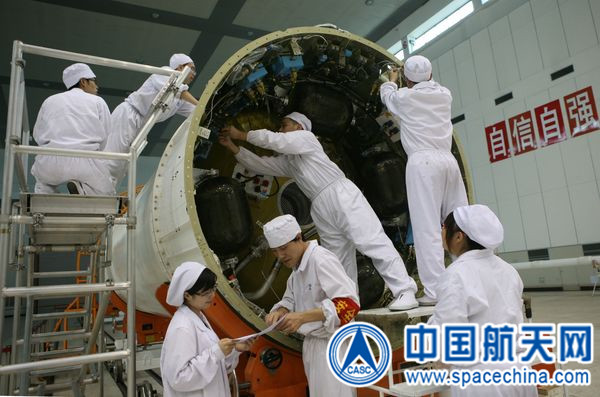
| Type | K2-1 |
| Length | 26.5m |
| Diameter | 2.25m |
| Inert Mass | ~6,000kg |
| Propellant Mass | ~75,000kg |
| Fuel | Kerosene |
| Oxidizer | Liquid Oxygen |
| Tank Material | Aluminum Alloy |
| Tank Construction | Separate Bulkheads |
| Tank Pressurization | Engine Bleed, Helium |
| Propulsion | 1 x YF-100 |
| Engine Specs | See Stage 1 above |
| Burn Time | ~180 sec |
| Attitude Control | Two-Axis Engine Gimbaling |
Long March 7 employs four liquid-fueled rocket boosters clustered around the Core Stage. They are referred to as K2-1 rocket modules and share the 2.25-meter diameter of the Long March 2F rocket but are stretched to a length of around 26.5 meters. The inert mass of the booster is around six metric tons.
The boosters also employ the common design facilitating the Liquid Oxygen tank located above the Kerosene tank with the LOX feedline running through the center of the fuel tank. The LOX tank of K2-1 is around 13 meters in length while the Kerosene tank is approximately 6.6 meters long, allowing each booster to hold 75.5 metric tons of propellants.
The four boosters are topped by a light-weight aerodynamic cap and feature outward facing fins to provide aerodynamic stabilization during the initial flight sequence. Each of the boosters sports a single YF-100 engine, giving Long March 7 a total liftoff thrust of 7,080 Kilonewtons (722 metric ton force) which creates an initial thrust to weight ratio of 1.2.
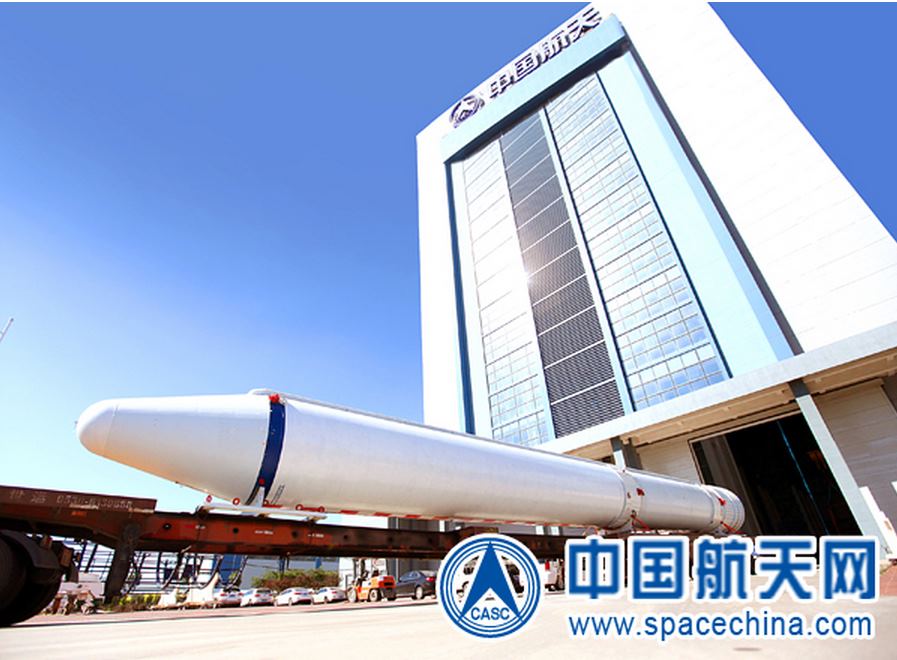
Second Stage.
| Type | K3-2 |
| Length | ~11.5m |
| Diameter | 3.35m |
| Inert Mass | ~6,000kg |
| Propellant Mass | ~65,000kg |
| Fuel | Kerosene |
| Oxidizer | Liquid Oxygen |
| Tank Material | Aluminum Alloy |
| Tank Construction | Separate Bulkheads |
| Tank Pressurization | Helium |
| Propulsion | 4 x YF-115 |
| Propellant Feed | Turbopump |
| YF-115 Thrust (Vac) | 180kN |
| Impulse (Vac) | 341.5s |
| Total Thrust | 720kN |
| Throttle Range | 80-100% |
| Ox. To Fuel Ratio | 2.5 |
| YF-115 Length | 2.33m |
| YF-115 Diameter | 0.95m |
| Restart Capability | Yes |
| Burn Time | Variable |
| Attitude Control | Two-Axis Engine Gimbaling |
The second stage of the Long March 7 rocket is 3.35 meters in diameter, the same as the first stage. The K3-2 rocket module is around 11.5 meters long and has an inert mass of approximately 5.5 metric tons.
In design, the second stage is similar to the first stage with the Liquid Oxygen tank located above the Kerosene tank and facilitating the pressurant bottles. At launch, the second stage holds 65 metric tons of propellants.
The K3-2 rocket module is powered by four YF-115 engines that are also employed by the Long March 6 rocket. YF-115 has been developed between 2002 and 2014 as China’s primary Kerolox engine optimized for operation in vacuum conditions, making it suitable for upper stages.
It employs an oxidizer-rich staged combustion cycle, following the Russian example after the Chinese obtained documentation detailing the Russian RD-120 engine in the 1990s. The engine is China’s first upper stage engine to employ a staged-combustion cycle.
YF-115 is 2.33 meters long and 0.95 meters in diameter. It operates at a chamber pressure of 120 bar to generate a thrust output of 180 Kilonewtons as a specific impulse of 341.5 seconds. It has a nozzle ratio of 88, optimized for operation in the rarefied upper atmosphere. The YF-115 engine can be throttled between 80 and 100% of rated performance.
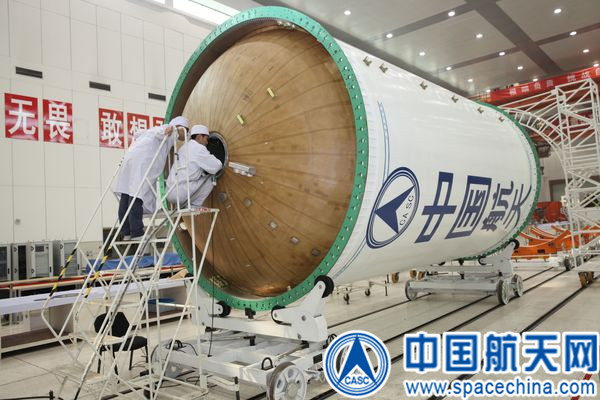
Payload Fairing
| Fairing Type | Composite Fairing |
| Fairing Diameter | 4.2m |
| Fairing Length | 12.4m |
| Payload Envelope | 3.8m |
The Payload Fairing is positioned on top of the stacked vehicle and its integrated spacecraft. It protects the vehicle against aerodynamic, thermal and acoustic environments that the launcher experiences during atmospheric flight. When the launcher has left the atmosphere, the fairing is jettisoned. Separating the fairing as early as possible increases ascent performance.
The baseline fairing design for the Long March 7 is a fairing 4.2 meters in diameter and 12.4 meters in length offering a payload envelope 3.8 meters in diameter – suitable for a variety of satellites including Geostationary Communications Satellites. Other fairing options, based on the current CZ-2/4 fairing designs will also be adapted for use on the Long March 7 rocket.
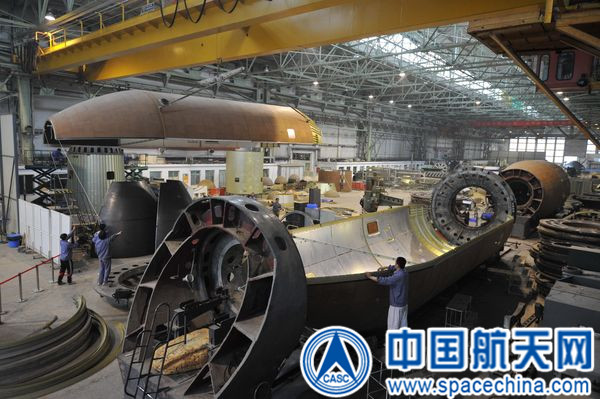
Vehicle Derivations
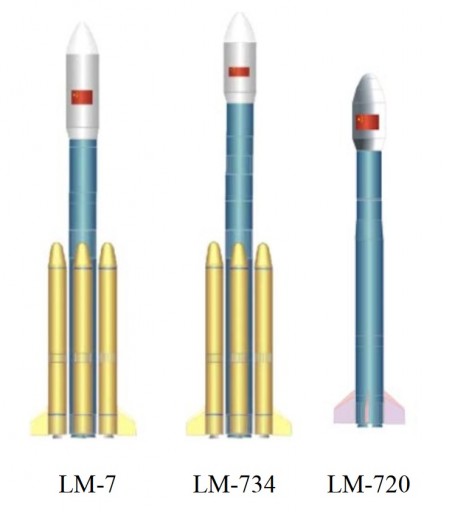
In an initial design proposal, there were to be three different Long March 7 versions to cater to different payload needs by flying the vehicle with zero, two or four liquid-fueled boosters. Another proposal called a pair of CZ-7 versions with either two or four boosters as well as the option of adding a small-diameter HO Upper Stage developed for the Long March 5 rocket.
In a paper published by CALT in 2014, two derived versions of the CZ-7 are presented to be under study. The first version, tentatively known as CZ-734, would fly the two-stage CZ-7 as presented on this page plus a cryogenic third stage identical to that of the Long March 3A rocket. This would increase the vehicle’s Geostationary Transfer Orbit capability to 7,000 Kilograms, allowing it to lift the heaviest communications satellites currently in operation.
A second version, CZ-720, would only use the CZ-7 core stage with no boosters plus a second stage identical to the third stage of Long March 3A to allow the vehicle to lift 2,900 Kilograms into a 700-Kilometer Sun Synchronous Orbit.
Optional 2nd/3rd Stage (as of 2014)
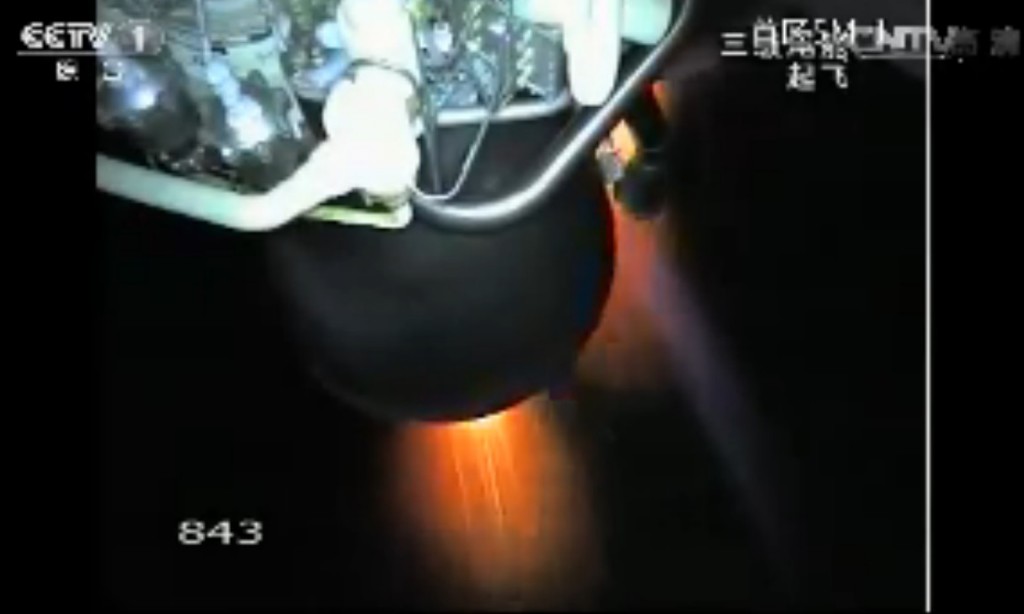
| Type | CZ-3A Third Stage |
| Length | 12.38m |
| Diameter | 3.0m |
| Launch Mass | 20,933kg |
| Empty Mass | 2,740kg |
| Fuel | Liquid Hydrogen |
| Oxidizer | Liquid Oxygen |
| Propellant Mass | 18,193kg |
| Propulsion | YF-75 |
| Thrust | 156.9kN |
| Specific Impulse | 4,312Ns/kg |
| Chamber Pressure | 37.6bar |
| Area Ratio | 80 |
| Restart Capability | Yes |
| Prop Utilization | Yes |
| Burn Time | 469s |
| Control | Engine Gimbaling (Pitch & Yaw) |
| Attitude Control Sys | 4x70N, 8x40N (Roll, Pitch & Yaw) |
| Prop Management | 2x300N, 2x45N |
The CZ-3A-type stage is a cryogenic upper stage that provides re-ignition capability to perform GTO or SSO insertions. Overall, the stage is 12.38 meters long with a reduced diameter of 3.0 meters having an inert mass of 2,740 Kilograms. The third stage carries a total propellant load of 18,193 Kilograms of Liquid Hydrogen and Liquid Oxygen.
The LH2 tank is located above the LOX tank and the two share a common bulkhead. The two tanks are equipped with propellant level sensors that provide information of the Propellant Utilization Sensor of the vehicle that then provides data to the telemetry and control system to adjust the mixture ratio to optimize the residual propellants left inside the stage after burnout and increase overall launch vehicle performance. The Propellant Level Meters are also used during propellant loading.
The stage is equipped with an YF-75 cluster of two cryogenic main engines providing a total vacuum thrust of 156.9 Kilonewtons (1,600 Kilogram-force) operating at a chamber pressure of 37.6 bar. The engines are optimized for operation in vacuum conditions with an area ratio of 80:1. Two allow CZ-3E to fly GTO missions, the engine can re-ignite on a second burn following an initial boost into a Parking Orbit. This second burn then delivers that vehicle to its elliptical GTO or escape trajectory. The engines can be gimbaled for vehicle control.
Propellant tank pressurization is accomplished using high-pressure Helium for the LH2 tank and a combination of Helium and gaseous LOX.
The stage is equipped with a monopropellant Propellant Management and Attitude Control System. The Propellant Management System is used for propellant settling burns ahead of main engine burns. The system consists of two 300-Newton thrusters and two 45-Newton thrusters. In addition to propellant management, the thrusters are also used for performance optimization during engine burns and for a variable Velocity Adjustment after the second burn of the upper stage to optimize the insertion trajectory.
The Attitude Control System of the stage is used during coast phases for vehicle re-orientations and to orient the stack for spacecraft separation. It consists of three banks of thrusters, one for each axis. Pitch control is provided by two 70-Newton and two 40-Newton thrusters. For Yaw-actuation, the system also uses two 70N and two 40N jets. Roll control is provided by four 40N thrusters.
All PM and ACS thrusters are fed from a single Hydrazine tank that is pressurized using high-pressure gas that is stored in two spherical tanks.

